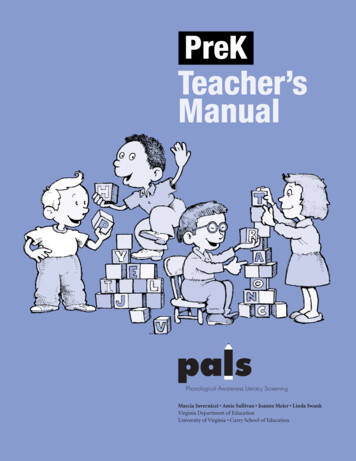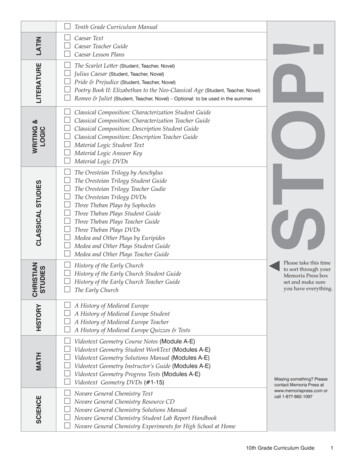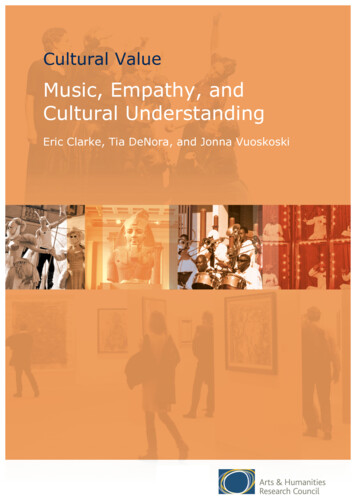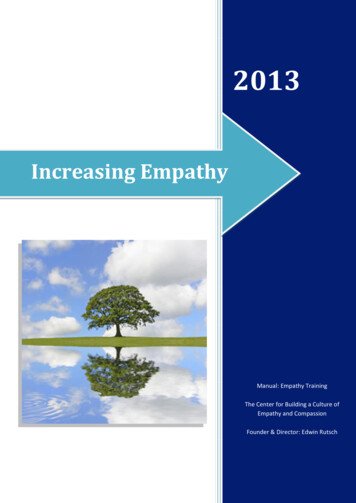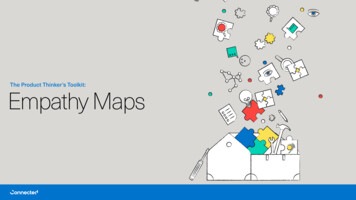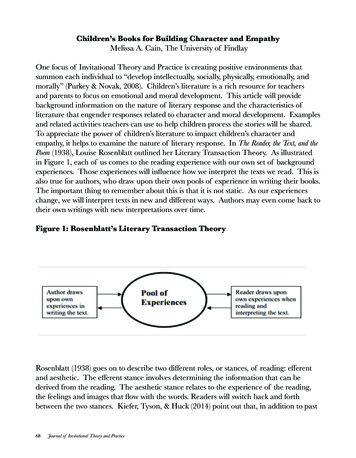
Transcription
K to Grade 2 Personal Health SeriesEmpathyKidsHealth.org/classroomTeacher’s GuideShowing empathy is an important part of being a friend and getting along withpeople. It means you can think about and understand how other people are feeling.These activities will help your students understand how to describe their ownfeelings and how to be supportive of each other.This guide includes: Standards Related Links Discussion Questions Activities for StudentsRelated KidsHealth LinksArticles for Kids:Talking About Your Feelings Reproducible How Cliques Make Kids Feel Left OutKidsHealth.org/en/kids/clique.htmlStandardsThe Scoop on GossipThis guide correlates withthe following National HealthEducation Standards:Students will: Demonstrate the ability to useinterpersonal communicationskills to enhance health andavoid or reduce health risks. Demonstrate the ability touse decision-making skills toenhance health. Demonstrate the ability to usegoal-setting skills to enhancehealth. Demonstrate the ability topractice health-enhancingbehaviors and avoid or reducehealth risks. Demonstrate the ability toadvocate for personal, family,and community health.KidsHealth.org/en/kids/gossip.htmlHow Do I Help a Kid Who's omeone in My Friend’s Family Died: What Should I aying You're SorryKidsHealth.org/en/kids/sorry.htmlGetting Along With ers.htmlGetting Along With on QuestionsNote: The following questions are written in language appropriate for sharing withyour students.National Health EducationStandards: ndex.htm1.What kinds of things make you feel happy? Sad? Angry? Excited? How do you actwhen you feel these ways? Can you tell how your parents or your brothers orsisters or your friends are feeling? How?2.How can you show a friend that you're really listening? What does carefullistening look like?3.How do you feel when somebody interrupts you? What do you do or say?4.If you found out a friend or classmate was feeling sad, what would you say? Howwould you help your friend or classmate feel better? 2016 The Nemours Foundation/KidsHealth. Reproduction permitted for individual classroom use.
K to Grade 2 Personal Health SeriesEmpathyActivities for StudentsNote: The following activities are written in language appropriate for sharing with your students.I Feel .Objectives:Students will: Identify different feelings Identify and describe the nonverbal ways (body language) people show their feelingsMaterials: Art supplies (colored pencils, markers, crayons)"I Feel " handoutClass Time:45 minutesActivity:People feel all kinds of different feelings: happy, sad, excited, nervous, scared, angry, lonely, confused,uncomfortable, surprised, shy, embarrassed, loved, and proud. Sometimes people talk about how they're feeling, andother times they might not say anything, but their faces and bodies and movements may show how they feel.Stand up, and make sure you have enough room to move without bumping into a classmate. I'll turn off the lights andsay, “Show how you look and how you move when you’re happy.” As soon as the lights go on, make a face that showshow you feel when you’re happy and move around in a happy way – without talking. When the lights go off, freeze. I'llname another feeling and then turn on the lights again. Show your feeling through your facial expressions and yourmovements. After a few minutes, stop and talk about how you look and move for different feelings. How do you lookand move when you’re sad? When you’re excited? When you’re feeling shy?Now think about what happens that makes you feel certain feelings. Write down your thoughts on the "I Feel "handout. Share what you write with the class.Extensions:1.Colors sometimes seem to match feelings. Which colors do you think seem happy? Sad? Angry? Excited? Do anycolors overlap? Choose three colors and create a picture that shows how you feel.2.How closely can you pay attention to someone’s body language? Pair up with a partner. Decide who will be theleader and who will be the follower. The leader begins by making an expression (smile, frown) slowly enough sothat the follower can "mirror" him or her. Leaders, don’t try to trick the followers – you want them to follow you.Followers, play close attention to how the leaders move. What are their eyes doing? Their mouths? Their hands?Change roles and start over. 2016 The Nemours Foundation/KidsHealth. Reproduction permitted for individual classroom use.
K to Grade 2 Personal Health SeriesEmpathyHow Would You Feel if Objectives:Students will: Recognize the feelings and perspectives of others Role-play and brainstorm ways to respond to people depending on how they're feelingMaterials: Puppet or stuffed animal"How Would You Feel if " handoutClass Time:30 minutesActivity:Getting along involves thinking about how other people are feeling. When something happens, thinking about howyou would feel in that situation can give you an idea about how someone else might feel. It’s important to thinkabout how other people might be feeling and what you can say and do to support them.You and two other classmates are going to role-play a few different situations from the "How Would You Feelif " handout. Role-play at least three of the situations. Then, share with the class some of the ways your groupresponded in the situations.Extensions:1.What makes a good listener? How can you tell when someone is listening carefully? Make a list describing whatgood listening looks and sounds like.2.In small groups, toss around a beanbag or small ball. How could you encourage the other kids in your group? Ifthe ball is dropped or missed, what could you say to be supportive?Reproducible MaterialsHandout: I Feel empathy handout1.pdfHandout: How Would You Feel if empathy handout2.pdfKidsHealth.org is devoted to providing the latest children’s health information. The site, which is widelyrecommended by educators, libraries, and school associations, has received the “Teachers’ Choice Awardfor the Family” and the prestigious Pirelli Award for “Best Educational Media for Students.” KidsHealth comesfrom the nonprofit Nemours Foundation. Check out www.KidsHealth.org to see the latest additions! 2016 The Nemours Foundation/KidsHealth. Reproduction permitted for individual classroom use.
Personal Health SeriesEmpathyName:Date:I Feel .Instructions: Think about your feelings and finish the following sentences. Next to each sentence, draw a picture that shows whatyou look like when you feel that way.I feel happy whenI feel sad whenI feel excited whenI feel frustrated whenI feel angry when 2016 The Nemours Foundation/KidsHealth. Reproduction permitted for individual classroom use.
Personal Health SeriesEmpathyName:Date:I feel lonely whenI feel embarrassed whenI feel scared whenI feel proud whenI feel loved when 2016 The Nemours Foundation/KidsHealth. Reproduction permitted for individual classroom use.
Personal Health SeriesEmpathyHow Would You Feel if Instructions: Read the different situations. If this happened to you, how would you feel? What would you want people to say toyou? In your groups, act out the situations. Take turns being the kid in these situations. How could you let people know howyou're feeling? What could you say or do to help the kid feel better? Share how your group talked about the different problems. you just found out yourfamily is moving at the endof the school year. you just found outyou're going to have anew baby brother orsister in a few months. you just got back fromvacation and you realize youlost one of your favorite toys. you see two kids playingand you ask if you can play,too, but the kids say no. you’re playing basketballand your team needs 2points to win, but yourshot misses. you get really sick and can'tbe in the school concert. 2016 The Nemours Foundation/KidsHealth. Reproduction permitted for individual classroom use.
KidsHealth.org is devoted to providing the latest children's health information. The site, which is widely recommended by educators, libraries, and school associations, has received the "Teachers' Choice Award for the Family" and the prestigious Pirelli Award for "Best Educational Media for Students." KidsHealth comes
